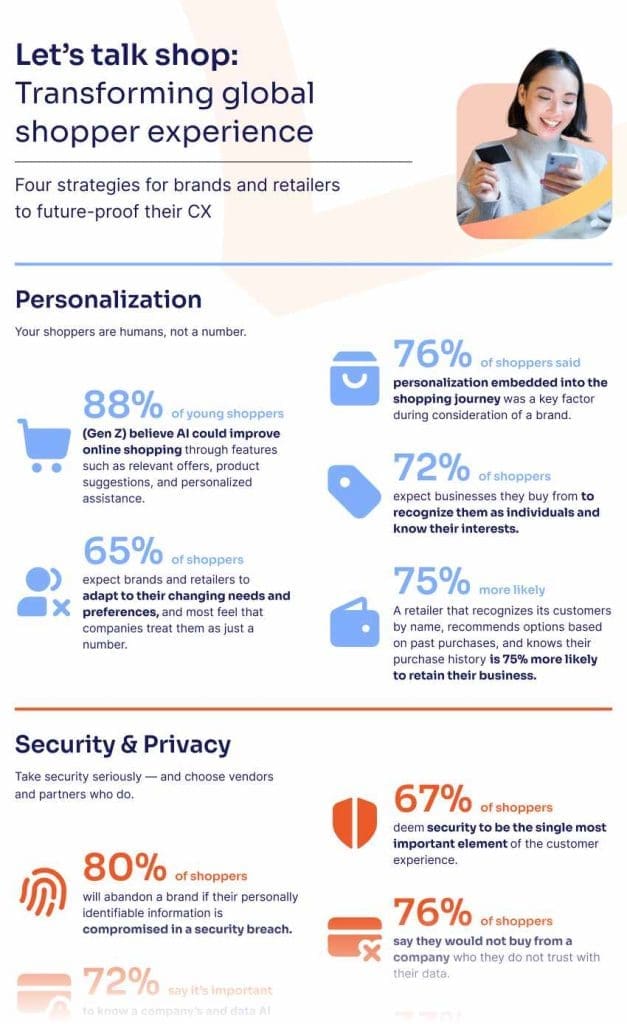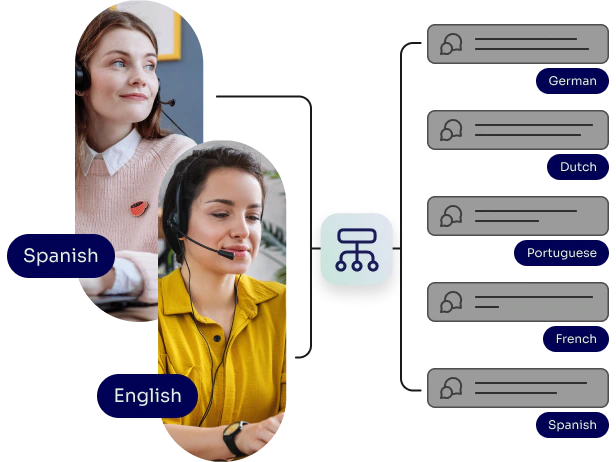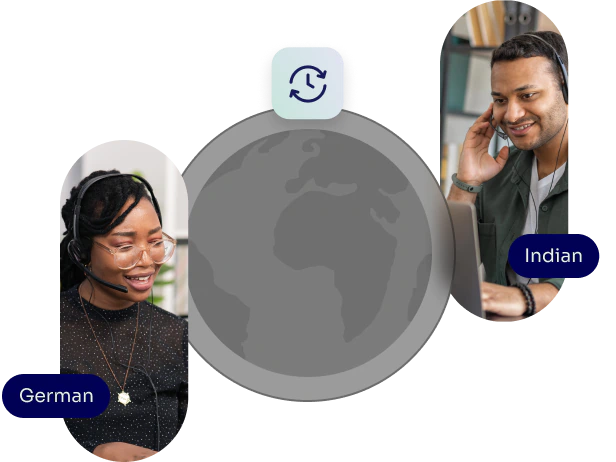Transforming global shopper experience
Four strategies for brands and retailers to future-proof their CX
The very definition of shopper loyalty has changed, and many different criteria have emerged that could make or break your relationship with your customers.
Consumers want to be seen, heard and understood by brands. So what are the biggest priorities for retail leaders looking to earn customer trust worldwide and stay ahead of the pack?

The four ultimate focus areas for brands + retailers
Whether you’re enhancing the shopping experience or leveraging technology to fuel innovation, here are the four areas you must prioritize to change the game for shoppers worldwide.
We also have some hard evidence for what shoppers want and how you can start exceeding their expectations now, from delivering hyper-personalized and secure experiences to unparalleled customer service that would make your customers choose you over and over again.

Area 1: Personalization
Your shoppers are humans, not a number.
How shoppers define personalization
72% of shoppers say they expect the businesses they buy from to recognize them as individuals and know their interests. They define personalization as positive experiences of being made to feel special.
Personalization is when a brand or retailer:
- recognizes shoppers by name
- knows their purchase history
- recommends options based on past purchases, like relevant offers and product suggestions
- provides personalized assistance
Why personalization is important
- 76% of shoppers say that having personalization embedded into the shopping journey is a key factor in prompting their consideration of a brand.
- 78% of shoppers say personalization makes them more likely to repurchase.
Area 2: Security and privacy
Take security seriously — and choose vendors and partners who do.
What security entails
80% of shoppers will abandon a brand if their personally identifiable information is compromised in a security breach.
Personally identifiable information is any information that can be used alone, or in combination with other information, to identify an individual.
Your shoppers expect transparency on
- what data you’re collecting
- why you’re collecting the data
- what you’re doing with the information
- whom you’re sharing their information with – and only if they allowed it
Why security is important
- Consumers spend more at companies they trust — 46% purchased more, and 28% paid a premium.
- 4 in 10 customers have switched brands due to lack of trust.
- 76% of shoppers say they would not buy from a company who they do not trust with their data.
Area 3: Employee experience
Empowered employees improve shopper experience.
What employee experience is
- 82% of shoppers said how brands treat employees is the number one factor that impacts their purchase decisions the most.
- 9 out of 10 shoppers claim it’s important to them that the company they purchase from treats its employees well.
Every day, your employees make decisions that affect your business. To keep them engaged at work, you must
- equip them with the right tools to perform their tasks
- give them the resources they need to be productive
- use the right technology to take repetitive, low-impact work off their plates
- provide all the accurate, up-to-date data they need to stay informed and succeed at work
Why employee experience is important
- Brands with high employee engagement see a jump of about 10% in customer loyalty.
- It has a direct impact on the bottomline too — a 23% increase in profits.
Area 4: Customer service
Great customer service drives value — and revenue.
What great customer service looks like
- 88% of shoppers are more likely to purchase again and forgive brands for their missteps after receiving good customer service.
- 47% of customers feel less valued when they face difficulty reaching or talking to unsupportive customer service agents.
Excellent customer service makes your shoppers feel empowered when buying and using your product. This means your customer support
- meets your shoppers where they are, on their desired channels and at their level of expertise
- reduces customer effort in solving their problems
- proactively anticipates their needs and gives them the resources they need at the right time
- allows seamless communication in their preferred language
Why good customer service is important
- Businesses lose a significant amount of money over subpar support: Poor customer service puts $3.7 trillion annually in sales at risk.
- The cost of poor customer service: Just one bad interaction and 3 out of 4 customers will jump ship and stop buying from a brand.

Some benefits of Language I/O include
Efficiency
Real-time AI-powered translation saves agent time and reduces effort – and integrates directly to CRMs, allowing your current team of agents to start translating right where they communicate, in 150+ languages and in less than 24 hours.

Accuracy
High-quality and context-aware translations – misspellings, slang, jargon, etc., are all relayed accurately.

Global expansion
Highly scalable, which means expanding to new languages and new regions is a breeze; you’ll continue to have fast, efficient coverage in 150+ languages during
- unexpected influxes and high volumes
- seasonal spikes
- new product releases and updates with very specific features and nuances

Customization
Depending on the domain, industry or preferences, your translations are fine-tuned for factors like voice, tone and terminology.

Reduced costs and wait times
You reduce costs by 60% and response times by 50% while keeping CSAT scores high — even in rare, difficult-to-translate languages like Pashto or expensive-to-translate ones like Nordic languages.
Our customers love us